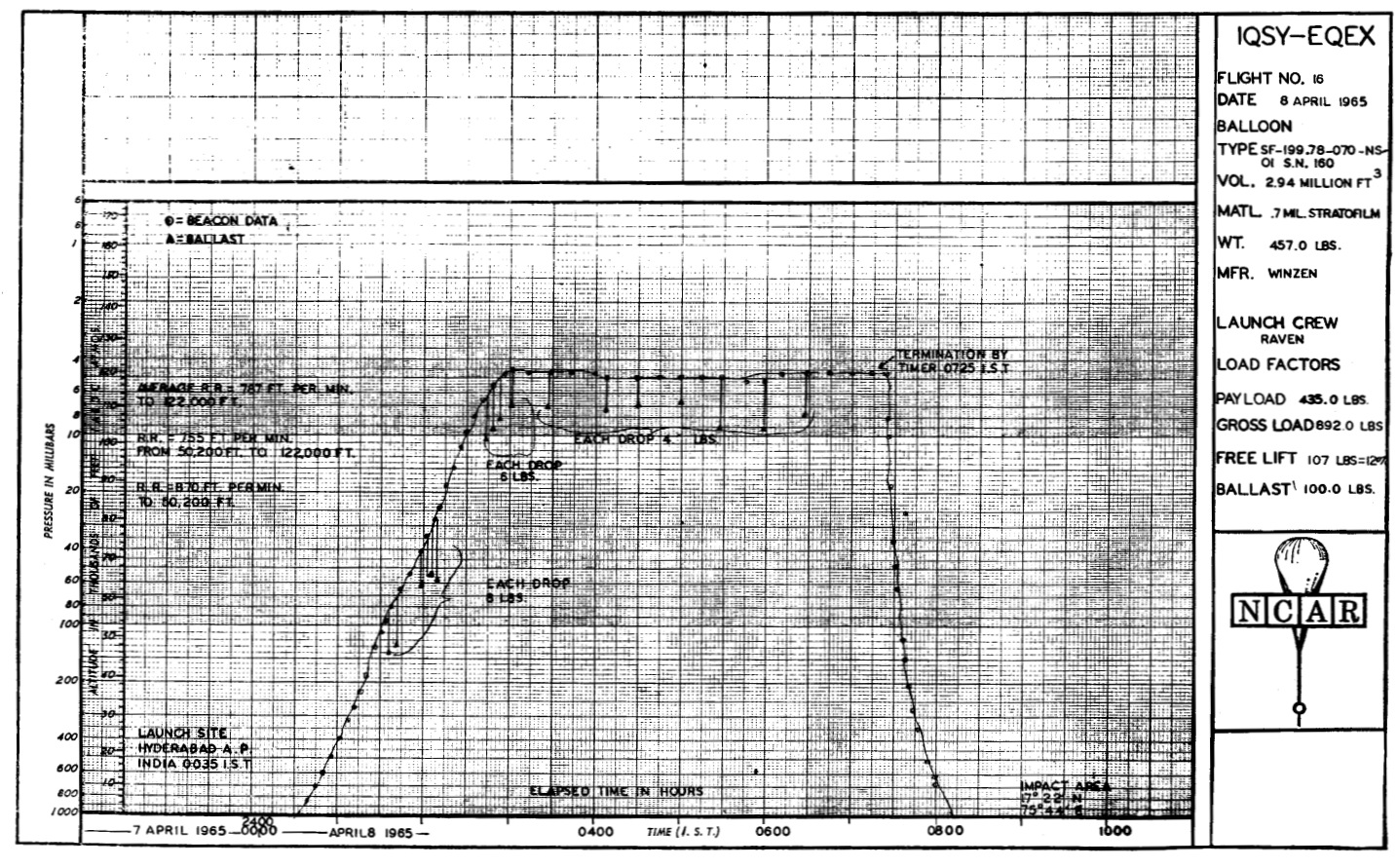Purpose of the flight and payload description
This flight was part of a balloon expedition to study cosmic rays in the vicinity of the equator during the International Quiet Sun Year (IQSY) organized and managed by the National Center for Atmospheric Research as a joint United States - India activity. The program was conducted in Hyderabad, India during the late winter and early spring of 1965.
The main objective of the flight was to launch a X-Ray Telescope developed at the Southwest Center for Advanced Studies in Dallas, Texas. The experiment studied the energy spectrum of the cosmic radiation in the energy range 15 to 40 Bev, which was a portion of the spectrum little known at the time.
As additional payloads were also included two experiments provided by Osmania University, Hyderabad, India: an experiment to study the effects of cosmic rays on seedlings and another one aimed to study the genetics effects of cosmic rays
Details of the balloon flight

Balloon launched on: 4/8/1965 at 00:35 ist
Launch site: Osmania University Campus, Hyderabad, India
Balloon launched by: Raven Industries Inc.
Balloon manufacturer/size/composition: Zero Pressure Balloon Winzen 2.940.000 cuft (0.7 Mil. Stratofilm)
Balloon serial number: SF-199.78-070-NS-01 S/N 160
End of flight (L for landing time, W for last contact, otherwise termination time): 4/8/1965 at 7:25 ist
Balloon flight duration (F: time at float only, otherwise total flight time in d:days / h:hours or m:minutes - ):
Landing site: Payload impact at coordinates: 17º 22' N, 75º 44' E
Campaign: No Data IQSY-EQEX
Payload weight: 435 lbs
Overall weight: 892 lbs
All balloons launched on the expedition had been launched late enough in the morning to reach altitude after sunrise; however, this particular experiment required an early launch so the experiment could be at altitude before sunrise. Numerous balloons flown in India had passed through tropopause temperatures of -75 to -83 C during a sunlight ascent, without bursting. There was some concern about whether or not a balloon could successfully reach altitude through a -81 C tropopause temperature in total darkness. Since the ascent was in darkness, an additional 2% free lift was used. An additional 30 lb of ballast was used to increase the ascent rate in the event the balloon stopped at the tropopause. With the help of lights from the various trucks and cars at the launch site, the balloon was launched at 00:35 local time on 8 April. An ascent rate of 870 ft/min was established to 50,200 ft and 755 ft/min to an altitude of 122,000 ft. After 4.5 hr at ceiling, the flight was terminated. Impact occurred at 170 22' N, 750 44' E. The telescope sustained no damage on impact and could be flown again after a routine check.
External references
- A celestial source of X rays in the energy range 20 to 58 keV Proceedings of the 9th International Cosmic Ray Conference, Vol. 1, p.449
- Ballooning Support for Cosmic-Ray Experiments NCAR Technical Note NCAR/TN-20, September 1966
- Energy Spectra of a Number of Celestial X-Ray Sources in the Energy Range from 2 to 60 Kiloelectron Volts Science, 154(3752), 1000-1002
15885If you consider this website interesting or useful, you can help me to keep it up and running with a small donation to cover the operational costs. Just the equivalent of the price of a cup of coffee helps a lot.

